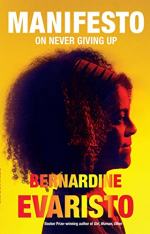|
This section contains 891 words (approx. 3 pages at 400 words per page) |

|
Manifesto: On Never Giving Up Summary & Study Guide Description
Manifesto: On Never Giving Up Summary & Study Guide includes comprehensive information and analysis to help you understand the book. This study guide contains the following sections:
This detailed literature summary also contains Topics for Discussion on Manifesto: On Never Giving Up by Bernardine Evaristo.
The following version of this book was used to create the guide: Evaristo, Bernardine. Manifesto: On Never Giving Up. Grove Press, 2022.
In her intro to Manifesto, Evaristo explains her intention to reflect on elements underlying her lifelong career in the arts, including her eventual widespread success with her novel Girl, Woman, Other. In “One: heritage, childhood, family, origins” (3), she begins by considering the cultural and personal values passed on to her through her parents and their families. She reflects on the racism she, her Nigerian father, and her biracial siblings experienced in Britain. She credits her parents’ activism and her father’s community involvement with forming her own activist roots, and acknowledges that her mother and grandmother, through pursuing autonomy for themselves in a patriarchal society, laid the groundwork for her to have an independent, creative life.
In “Two: houses, flats, rooms, homes” (47), Evaristo recollects the various spaces she has lived in, starting with the four-story family home in which she grew up. She reflects on the importance of privacy and having her own space during her early forays into poetry, when she did not show her work to anyone. In telling of the apartments and neighborhoods she has lived in, Evaristo considers the dangers inherent in residing alone as a woman, and the significance of London as a backdrop in her fiction.
In “Three: the women and men who came and went” (77), Evaristo charts her romantic relationships and sexual encounters from youth to middle age, while showing the progression of her sexuality. As a teenager she liked boys, though she suggests that wanting a boyfriend was likely partly due to cultural conditioning. As a young woman, she became aware of an attraction to women and immersed herself in lesbian and feminist culture. She notes two significant relationships during this time: A fulfilling one with a Dutch woman she calls eX, and a harrowing one with an abusive woman she refers to as The Mental Dominatrix, who attempted to control all aspects of her life, including her writing. Evaristo left The Mental Dominatrix after she had begun to explore a renewed attraction to men. This was followed by a frustrating and fruitless period during which she attempted unsuccessfully to date men, that finally ended when she met her husband, David. She found marriage offered her the stability and freedom she needed to concentrate on her writing.
“Four: drama, community, performance, politics” (115) revolves around Evaristo’s involvement in Theatre of Black Women, a theater company that she started with two friends from college. Evaristo recollects how in her youth she found a local theater program crucial to forming a sense of self-expression and individuality as well as community. She reflects on her reasoning for focusing on community theater rather than pursuing a solo acting career, in which she would have been limited in the roles open to her as a Black woman. She also considers the link between her involvement in theater and her fiction writing, and how each inspired the other.
“Five: poetry, fiction, verse fiction, fusion fiction” (143) explores the evolution of Evaristo’s writing career with a focus on the creation of individual works, as well as the specifics of publishing. Evaristo recollects that she rewrote Lara, a novel telling the story of opposition to her parents’ interracial marriage, in verse after having first written it in prose. In charting the progress of other works, she notes how they similarly began in one form before she discovered another. Evaristo stresses the impermanent nature of books in both the writing and publishing stages.
In “Six: influences, sources, language, education” (177), Evaristo examines her linguistic and educational influences. She considers organic influences from her childhood that may have had an effect on her desire to become a poet, such as the Catholic masses she attended and her father’s broken English. The lack of Black British poets at the time of her youth, along with the lack of inspiration she found in her school curriculum, was discouraging, and she was drawn to writing by African American women. She decided to pursue higher education much later, in her 40s, and suggests that early academic failure does not signal an inability to achieve success later on.
“Seven: the self, ambition, transformation, activism” (193) covers Evaristo’s approach to persisting in her career as a writer as well as fighting for inclusion in literature. She explains that her ability to overcome the racist obstacles presented by the literary establishment was fostered by personal development strategies focused on maintaining a positive mental attitude (PMA). She goes on to say that she used the same general approach, after she became famous, to insist on the inclusion of other marginalized writers in literary spaces. She then reflects on the discriminatory attitudes that drive the marginalization of racialized people in publishing, including the false idea that racially marginalized people are always writing about racism and race and that their writing is not universally accessible.
In her “Conclusion” (215), Evaristo remarks that her approach to injustice has changed over the decades, and that she is now more interested in making alterations from within the system than destroying it. In “The Evaristo Manifesto” (221), she lists her strongest beliefs about creativity, which reflect the values she has written about throughout the memoir, ending with the importance of being grateful to one’s ancestors.
Read more from the Study Guide
|
This section contains 891 words (approx. 3 pages at 400 words per page) |

|



